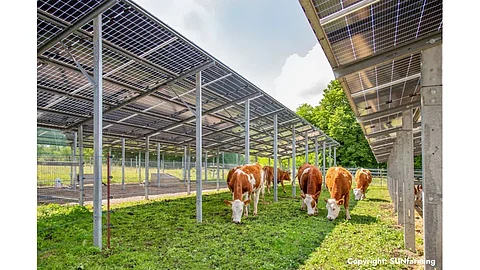

SUNfarming has brought on board France’s SPIE to build a substation for 753 MW agrivoltaic project
This capacity is planned to be installed on 500 hectares of land across 8 German districts
Land will be used for perennial fodder crop production and as temporary paddocks for calf and heifer breeding
At 753 MW, Europe’s largest agrivoltaic project is coming up in Germany across 8 districts with local agrivoltaic specialist SUNfarming GmbH joining hands with French multi-technical services provider SPIE to install a substation for the facility.
The project has come to the building permit phase within a 4-year development period. SUNfarming developed the agricultural concept for Klimapark Steinhöfel in close collaboration with an agricultural consultancy for local farms along with farmers from the region.
Planned to come up on close to 500 hectares of land, the agrivoltaic project will have bifacial glass-glass solar panels installed at a minimum height of 2.10 meters.
Once the solar panels have been installed, agricultural land will be used for perennial fodder crop production and as temporary paddocks for calf and heifer breeding.
“Klimapark Steinhöfel is SUNfarming’s largest pioneering project, which we successfully developed within just under four years, achieving regulatory approvals in all districts,” explained Martin Tauschke, Co-Founder and Managing Director of SUNfarming.
Under their collaboration, SPIE will be in charge of securing building permit and implementation planning along with material procurement for the substation, as well as assembly and commissioning.
Power generated from the facility will be fed into the grid with the help of 4 transformers. Construction work for the substation is scheduled to begin in Q3 2025, and commissioning in Q2 2026.
SUNfarming has been researching and developing its proprietary agrivoltaic systems for its projects and counts to have several GWs of agrivoltaic systems in development.
“We currently have several gigawatts of agrivoltaic systems in development, not only for use in crop and fruit cultivation but also for raising mother cows and calves, poultry and fallow deer,” shared SUNfarming’s Managing Director of Project Development, Edith Brasche. “Klimapark Steinhöfel is part of our research, demonstrating that agrivoltaic systems protect the environment, nature and groundwater against climate change while bringing real added value to rural regions.”
In their 2022 research, the University of Hohenheim in Stuttgart and Thünen Institute in Braunschweig concluded that installing solar panels on 1% of arable land in Germany can help cover around 9% of the country’s electricity demand. For agrivoltaic projects to be profitable, this electricity will need to be remunerated at €0.083/kWh (see Study Explores Agrivoltaics As Positive For Germany).
